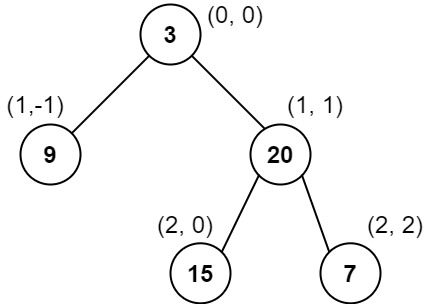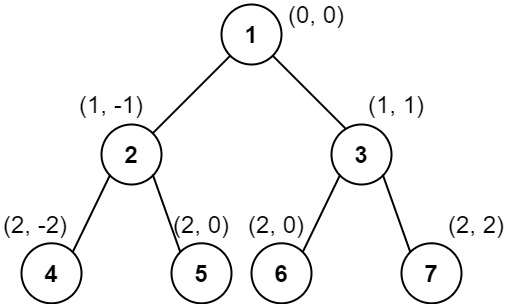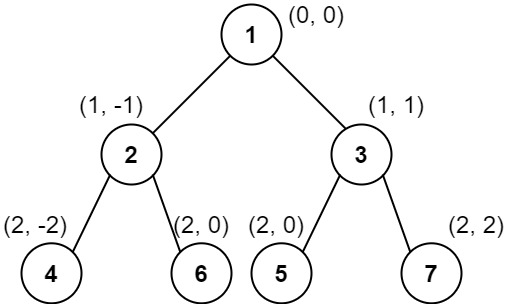Vertical Order Traversal of a Binary Tree
HardGiven the root of a binary tree, calculate the vertical order traversal of the binary tree.
For each node at position (row, col), its left and right children will be at positions (row + 1, col - 1) and (row + 1, col + 1) respectively. The root of the tree is at (0, 0).
The vertical order traversal of a binary tree is a list of top-to-bottom orderings for each column index starting from the leftmost column and ending on the rightmost column. There may be multiple nodes in the same row and same column. In such a case, sort these nodes by their values.
Return the vertical order traversal of the binary tree.
Example 1:

Input: root = [3,9,20,null,null,15,7] Output: [[9],[3,15],[20],[7]] Explanation: Column -1: Only node 9 is in this column. Column 0: Nodes 3 and 15 are in this column in that order from top to bottom. Column 1: Only node 20 is in this column. Column 2: Only node 7 is in this column.
Example 2:

Input: root = [1,2,3,4,5,6,7]
Output: [[4],[2],[1,5,6],[3],[7]]
Explanation:
Column -2: Only node 4 is in this column.
Column -1: Only node 2 is in this column.
Column 0: Nodes 1, 5, and 6 are in this column.
1 is at the top, so it comes first.
5 and 6 are at the same position (2, 0), so we order them by their value, 5 before 6.
Column 1: Only node 3 is in this column.
Column 2: Only node 7 is in this column.
Example 3:

Input: root = [1,2,3,4,6,5,7] Output: [[4],[2],[1,5,6],[3],[7]] Explanation: This case is the exact same as example 2, but with nodes 5 and 6 swapped. Note that the solution remains the same since 5 and 6 are in the same location and should be ordered by their values.
Constraints:
- The number of nodes in the tree is in the range
[1, 1000]. 0 <= Node.val <= 1000
Solution
Clarifying Questions
When you get asked this question in a real-life environment, it will often be ambiguous (especially at FAANG). Make sure to ask these questions in that case:
- What is the range of values for the node values in the binary tree? Are negative values possible?
- What should I return if the root is null or the tree is empty?
- In the case of multiple nodes at the same row and column, what is the tie-breaking rule for ordering them?
- Are there any memory constraints I should be aware of, given the potential size of the tree?
- How should the output be formatted exactly? Specifically, should it be a list of lists, and how should the inner lists be structured?
Brute Force Solution
Approach
The brute force method for vertical order traversal of a binary tree essentially tries to capture every single node and its horizontal position. It then organizes them based on these horizontal positions. It is an exhaustive approach that doesn't take any shortcuts.
Here's how the algorithm would work step-by-step:
- First, imagine each node in the tree has a 'horizontal level' number. The root starts at level 0.
- Go through the tree, level by level, and for each node, calculate its horizontal level. If you go left, subtract one from the level. If you go right, add one to the level.
- Store each node along with its calculated horizontal level.
- Once you've visited every node, find the smallest and largest horizontal levels that exist in your stored data.
- Now, go through each horizontal level, starting from the smallest and ending at the largest.
- For each horizontal level, collect all the node values that have that particular level.
- Finally, present the node values for each horizontal level in order from smallest to largest level. This is the vertical order traversal.
Code Implementation
class TreeNode:
def __init__(self, val=0, left=None, right=None):
self.val = val
self.left = left
self.right = right
def vertical_order_traversal_brute_force(root):
node_levels = []
def calculate_node_levels(node, level):
if not node:
return
node_levels.append((level, node.val))
calculate_node_levels(node.left, level - 1)
calculate_node_levels(node.right, level + 1)
calculate_node_levels(root, 0)
# Need this to determine what range of levels to iterate through.
if not node_levels:
return []
min_level = min(level for level, _ in node_levels)
max_level = max(level for level, _ in node_levels)
vertical_order = []
# Iterate through each horizontal level
for level in range(min_level, max_level + 1):
current_level_nodes = []
# Collect nodes at the current horizontal level
for node_level, node_value in node_levels:
if node_level == level:
current_level_nodes.append(node_value)
vertical_order.append(current_level_nodes)
return vertical_orderBig(O) Analysis
Optimal Solution
Approach
The key to solving this problem efficiently is to think about the tree's structure in terms of columns. We want to group nodes by their horizontal distance from the root and then order those groups by level.
Here's how the algorithm would work step-by-step:
- Imagine each node in the tree is located on a horizontal line relative to the root. The root is at position zero.
- As we explore the tree, keep track of the horizontal position of each node. Left children are one position less than their parent, and right children are one position more.
- Use a way to remember which nodes belong to which horizontal position (or column).
- Do a traversal of the tree (like breadth-first search) where you visit each node. As you visit a node, store its value into the correct column based on its horizontal position.
- Once you've visited every node, you'll have all the nodes grouped by their column.
- Finally, go through your columns from left to right, and within each column, list the node values in the order you found them during your traversal. This gives you the vertical order.
Code Implementation
from collections import deque
class TreeNode:
def __init__(self, val=0, left=None, right=None):
self.val = val
self.left = left
self.right = right
def vertical_order(root):
if not root:
return []
column_to_nodes = {}
queue = deque([(root, 0)])
while queue:
node, column_index = queue.popleft()
# Store the node value for the current column index.
if column_index not in column_to_nodes:
column_to_nodes[column_index] = []
column_to_nodes[column_index].append(node.val)
if node.left:
queue.append((node.left, column_index - 1))
if node.right:
queue.append((node.right, column_index + 1))
# Get column indexes in sorted order.
sorted_columns = sorted(column_to_nodes.keys())
result = []
# Construct the final result based on the sorted column indexes.
for column_index in sorted_columns:
result.append(column_to_nodes[column_index])
return resultBig(O) Analysis
Edge Cases
| Case | How to Handle |
|---|---|
| Null or Empty Tree | Return an empty list if the root is null, as there are no nodes to traverse. |
| Single Node Tree | Return a list containing a list with the root node's value, representing the single column. |
| Tree with all nodes having the same value | The algorithm should correctly assign columns and row to nodes with same value ensuring proper vertical order. |
| Highly skewed tree (e.g., all nodes on the left) | The algorithm should correctly handle unbalanced trees without stack overflow or performance issues. |
| Large tree (potential memory issues) | Consider using an iterative approach or a space-efficient data structure to prevent excessive memory consumption for large trees. |
| Negative node values | The algorithm should handle negative node values without any issues. |
| Nodes with zero value | The algorithm should handle zero values for nodes without issues. |
| Integer Overflow with column indices | Use appropriate data types (e.g., long) for column indices to prevent potential integer overflows, especially in very wide trees. |